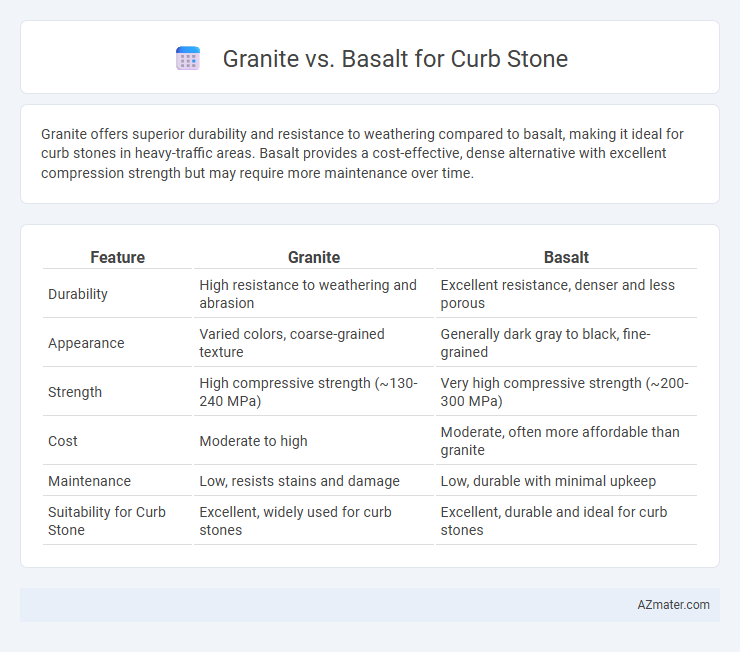Granite offers superior durability and resistance to weathering compared to basalt, making it ideal for curb stones in heavy-traffic areas. Basalt provides a cost-effective, dense alternative with excellent compression strength but may require more maintenance over time.
Table of Comparison
| Feature | Granite | Basalt |
|---|---|---|
| Durability | High resistance to weathering and abrasion | Excellent resistance, denser and less porous |
| Appearance | Varied colors, coarse-grained texture | Generally dark gray to black, fine-grained |
| Strength | High compressive strength (~130-240 MPa) | Very high compressive strength (~200-300 MPa) |
| Cost | Moderate to high | Moderate, often more affordable than granite |
| Maintenance | Low, resists stains and damage | Low, durable with minimal upkeep |
| Suitability for Curb Stone | Excellent, widely used for curb stones | Excellent, durable and ideal for curb stones |
Introduction to Granite and Basalt Curb Stones
Granite curb stones are renowned for their exceptional durability, natural grain patterns, and resistance to weathering, making them ideal for high-traffic urban environments. Basalt curb stones, formed from volcanic rock, offer a dense, fine-grained texture with superior compressive strength and excellent resistance to abrasion and chemical erosion. Both materials provide long-lasting performance, but granite's aesthetic appeal contrasts with basalt's rugged, uniform appearance, influencing selection based on project requirements.
Geological Origins of Granite and Basalt
Granite forms from the slow crystallization of magma beneath the Earth's surface, resulting in a coarse-grained texture composed primarily of quartz, feldspar, and mica. Basalt originates from rapidly cooled lava at the Earth's surface, characterized by a fine-grained, dense structure rich in iron and magnesium minerals. The intrusive igneous origin of granite contributes to its durability and unique speckled appearance, while basalt's extrusive volcanic origin makes it denser and more uniform in color, influencing their respective uses in curb stones.
Physical Properties Comparison
Granite exhibits high compressive strength, typically ranging from 130 to 200 MPa, making it ideal for heavy-load curb stone applications, while basalt also offers robust strength between 100 and 300 MPa with superior durability. Granite's coarse-grained texture provides excellent abrasion resistance, whereas basalt's fine-grained, dense structure resists weathering and chemical erosion more effectively. Both stones have low porosity, but basalt's slightly higher density (~2.9 to 3.1 g/cm3) enhances its longevity in harsh outdoor environments compared to granite's density of about 2.6 to 2.75 g/cm3.
Durability and Longevity
Granite is renowned for its exceptional durability and resistance to weathering, making it a top choice for curb stones that require long-lasting performance in high-traffic areas. Basalt, although also highly durable and dense, offers excellent resistance to abrasion but may be slightly more prone to chipping under extreme impact compared to granite. Both stones provide substantial longevity for curb applications, but granite's inherent hardness and low porosity give it a superior edge in maintaining structural integrity over extended periods.
Aesthetic Appeal and Color Variations
Granite offers a wide range of color variations including pink, gray, black, and white, providing versatile aesthetic appeal suited for upscale curb stones with natural speckling and polished finishes. Basalt, typically dark gray to black, delivers a sleek, modern look with a fine-grained texture that emphasizes uniformity and subtle elegance in curb stone applications. The choice between the two depends on desired visual impact: granite for vibrant, varied tones, basalt for consistent, minimalistic aesthetics.
Installation and Workability
Granite offers superior durability and ease of cutting, making it a preferred choice for curb stone installation due to its resistance to chipping and weathering during the process. Basalt, while dense and durable, presents challenges in workability because of its fine-grained texture, requiring specialized tools and longer installation times. The hardness of granite typically reduces labor costs and ensures precise fitting, whereas basalt's toughness demands skilled handling to achieve effective curb stone placement.
Maintenance Requirements
Granite curb stones require minimal maintenance due to their high resistance to weathering, scratching, and erosion, making them ideal for long-term durability in urban environments. Basalt curb stones, while also durable, may need more frequent cleaning and sealing to prevent surface discoloration and moss growth in damp conditions. Choosing granite reduces maintenance efforts and costs, ensuring a consistently pristine appearance over time.
Environmental Impact and Sustainability
Granite and basalt are both durable materials commonly used for curb stones, but their environmental impact varies significantly. Granite extraction involves extensive quarrying and high energy consumption, leading to greater carbon emissions, while basalt, being volcanic, often requires less energy to mine and process, contributing to lower environmental footprints. Basalt's natural abundance and local availability in many regions promote sustainability by reducing transportation emissions compared to granite, which is less widely distributed and typically involves longer shipping distances.
Cost Analysis: Granite vs Basalt
Granite curb stones generally cost more than basalt due to higher quarrying and processing expenses, but they offer superior durability and aesthetic appeal, often justifying the investment. Basalt tends to be more affordable and provides excellent strength and weather resistance, making it a cost-effective option for budget-conscious projects. Evaluating lifecycle costs, granite's longevity may offset its initial price difference when considering long-term maintenance and replacement expenses.
Conclusion: Choosing the Best Stone for Curbs
Granite offers superior durability and resistance to weathering, making it an excellent choice for long-lasting curb stones in high-traffic urban environments. Basalt provides a dense, abrasion-resistant surface with a darker aesthetic but can be more susceptible to chipping under heavy impact. Selecting the best stone depends on balancing granite's toughness and natural grain for enhanced longevity against basalt's cost-effectiveness and unique texture for curb projects.

Infographic: Granite vs Basalt for Curb Stone
 azmater.com
azmater.com